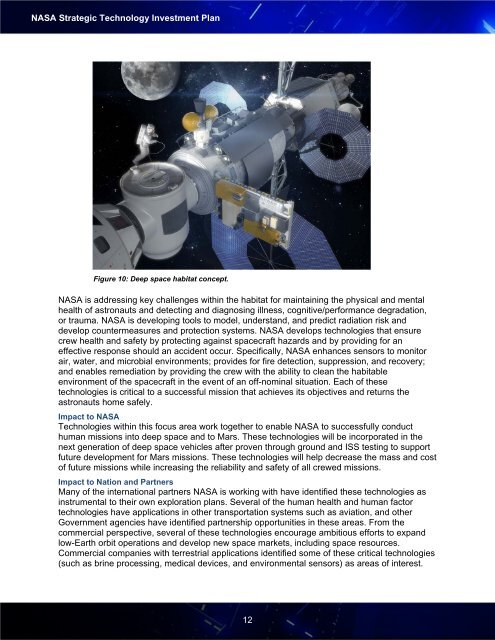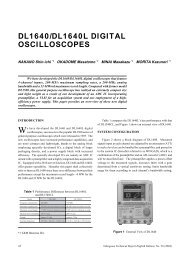2017-8-1_stip_final-508ed
Create successful ePaper yourself
Turn your PDF publications into a flip-book with our unique Google optimized e-Paper software.
NASA Strategic Technology Investment Plan<br />
Figure 10: Deep space habitat concept.<br />
NASA is addressing key challenges within the habitat for maintaining the physical and mental<br />
health of astronauts and detecting and diagnosing illness, cognitive/performance degradation,<br />
or trauma. NASA is developing tools to model, understand, and predict radiation risk and<br />
develop countermeasures and protection systems. NASA develops technologies that ensure<br />
crew health and safety by protecting against spacecraft hazards and by providing for an<br />
effective response should an accident occur. Specifically, NASA enhances sensors to monitor<br />
air, water, and microbial environments; provides for fire detection, suppression, and recovery;<br />
and enables remediation by providing the crew with the ability to clean the habitable<br />
environment of the spacecraft in the event of an off-nominal situation. Each of these<br />
technologies is critical to a successful mission that achieves its objectives and returns the<br />
astronauts home safely.<br />
Impact to NASA<br />
Technologies within this focus area work together to enable NASA to successfully conduct<br />
human missions into deep space and to Mars. These technologies will be incorporated in the<br />
next generation of deep space vehicles after proven through ground and ISS testing to support<br />
future development for Mars missions. These technologies will help decrease the mass and cost<br />
of future missions while increasing the reliability and safety of all crewed missions.<br />
Impact to Nation and Partners<br />
Many of the international partners NASA is working with have identified these technologies as<br />
instrumental to their own exploration plans. Several of the human health and human factor<br />
technologies have applications in other transportation systems such as aviation, and other<br />
Government agencies have identified partnership opportunities in these areas. From the<br />
commercial perspective, several of these technologies encourage ambitious efforts to expand<br />
low-Earth orbit operations and develop new space markets, including space resources.<br />
Commercial companies with terrestrial applications identified some of these critical technologies<br />
(such as brine processing, medical devices, and environmental sensors) as areas of interest.<br />
12







